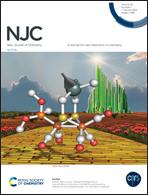Transition-metal ion-mediated morphological transformation of pyridine-based peptide nanostructures†
Abstract
Inspired by natural metallopeptides, we have rationally designed two pyridine-conjugated short peptides. These two peptide conjugates formed a pair of constitutional isomers that helped us describe their structure–function relationship. Both the isomers consisted of an equal number of aromatic amino acid residues, but shuffling was observed in the position of two key amino acids, viz; tyrosine and phenylalanine, which brought a remarkable change in their self-assembling behavior. The presence of specific functional groups and chemical diversity in both conjugates made them very active towards metal coordination. Both the constitutional isomers adopted different pathways of self-assembly, which could be further controlled or transformed by the use of transition metal ions. Interestingly, it was observed that the metal ions could precisely control the morphology of these metallopeptide nanostructures and make them more stable. Therefore, such artificial metallopeptides possess remarkable advantages over the natural counterparts primarily due to their tailor-made chemical structures.

- This article is part of the themed collection: #RSCPoster Conference


 Please wait while we load your content...
Please wait while we load your content...